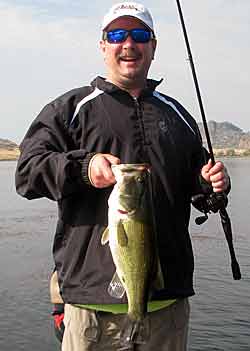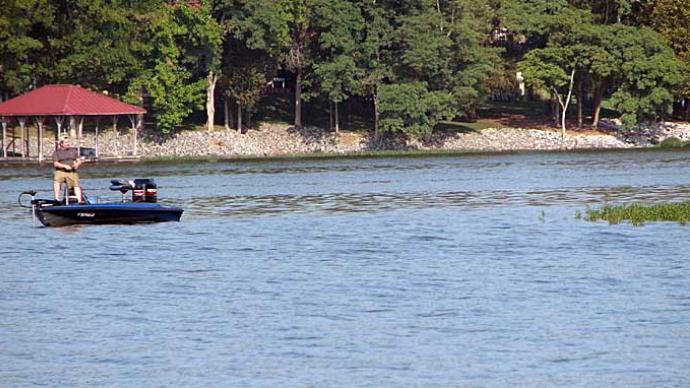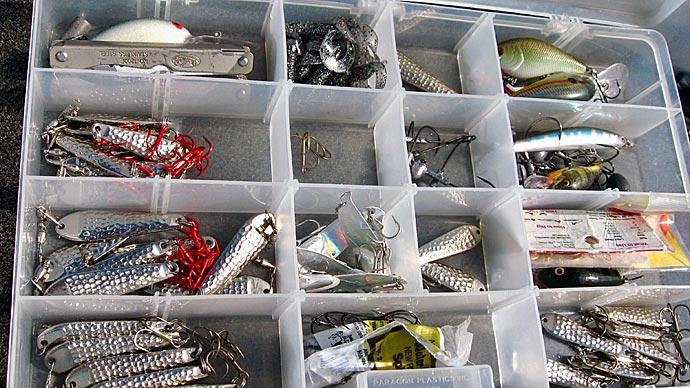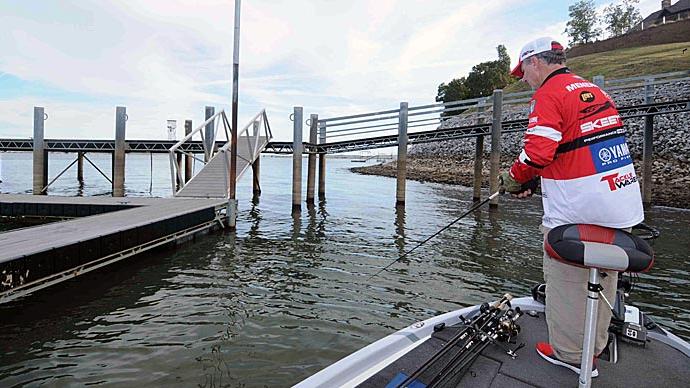
All of us appreciate that bass are challenging critters to catch. One pattern that requires fishermen to emphasize lure presentation is when they are suspended. Bass suspend for several reasons. Probably one of the most important is because concentrations of forage can tend to localize under certain conditions at specific depths. This is particularly true for shad. For example, there are certain times of the year in the summer, fall, and winter when the shad are represented on your graph as a solid cloud, which stratifies at reproductive levels in a lake. This is your first clue that there is a real chance that bass may be concentrating in the same depth strata, if for no other reason than the abundant presence of food.
The shad layer is often helpful in identifying not only where bass may be since they may be feeding on the baitfish, but also under some conditions, the shad help to define when there may be a reduced chance of bass being below a certain depth. For example, shad may be at a given depth because there is a concentration of small food sources at that level. However, when you run into the layering of shad in the summer, particularly over deep water, you may also observe the impact of either an oxycline or thermocline. For example, suppose there is a significant temperature shift (thermocline) at a level. In that case, the water that is ideal for holding shad may also be a giveaway that it provides a defined comfort zone in which the bass will stratify.
On the other hand, when the shad are not seen below a specific depth, there is a real possibility, particularly in the summer, that the deeper water may be oxygen-poor. Both of these environmental changes can occur in the summer months, but unlike the effect of the thermocline, the reduction of oxygen in the water does more than affect the comfort of the bass.
In reality, such oxygen-poor water would cause the bass and shad to "hold their breath" if they entered the layer. These environmental changes are not just limited to deep water but occasionally occur in more shallow lake areas. As I noted, the shad are good markers, which predicts the preferable depth where there are food concentrations and a comfort zone that likely will hold bass.
If given a chance, suspending fish will find cover in the preferred depth in which they are suspending. So if there is a clearly defined level, which seems to have concentrations of shad, then recognize that depth but also ask if there is some adjacent cover or structure in the area. When you make such a match, you are more likely to find more stable holding patterns for bass in that area. When you are in schools of suspended bass, do not leave the area without asking yourself, "Why were they there"? We all appreciate, for example, the importance of creek channels as holding places for bass. But over the years, it has amazed me how often the productive areas are depth related, which can, on a given day, be duplicated on the edge of other creek channels at that same depth in the same lake. Once you figure out the magic depth, the game plan is to cast along the drop and try to keep your lure at the given depth on the retrieve. The longer you can keep the bait in the correct depth, the better your chances of getting suspended bass to hit. For example, if they are suspended along a creek ledge, you may be wasting your time if you let the lure fall out of the strike zone by working it in the deeper wash of the channel. In contrast to the suspended fish holding adjacent to structure, the scattered suspended fish in more open water (even areas with the correct depth but without structure) are likely more rapidly moving schools, which are foraging on the suspended shad. After feeding, there is a good likelihood that they will return to the holding areas where there is cover or structure at the preferred depth.
I have mentioned that sometimes the bass seem to have a depth below which they are not readily willing to chase prey. From the fisherman's standpoint, this means if you fish a lure that passes below the level where the bass are comfortable, you may be fishing dead water for that part of the retrieve. Therefore, as is evident, the importance of a good graph cannot be over-emphasized when looking for possible levels where bass are holding and for subsequently working schools of suspended bass.
I have always been partial to crankbaits and have felt that understanding suspended bass is critical in how I present the lures. One of the things you have to learn about cranks is that while many look similar, they are often wildly different in not only action but also the depth at which they dive on retrieve. When selecting a series of lures, you must recognize the obvious importance of different colors and the depth at which the manufacturer has defined the specific bait that will run on retrieve. Trying lures, which permit you to fish at different depths, help you to define the strike zone for the suspended bass in an area. You can have the right color and action, but use a bait that does not dive deeply enough and go right over a school of bass, and they do not care. The other factor in working suspended bass is that they may be doing just that-suspending. In other words, they may be "hanging out" at a given depth and not actively involved in feeding. You can change that somewhat by putting a food-like morsel in their face. Sometimes it requires you to entice them into striking by creating a more erratic action on the bait as it passes through the level they are suspending. Any crankbait will catch more fish if you concentrate on stopping and starting the bait on the retrieve or at least varying the retrieve's speed. Such erratic action with a crank, just as with a topwater, can often trigger a response reflex and a strike when the bass is not inclined to feed.
If there is adequately oxygenated water, bass may suspend just off the bottom. Again, your graph and your first fish can tell you a lot about the potential for suspended bass being present.
I often emphasized the importance of fishing for suspended bass in a given layer of water on many occasions. The smaller the strike zone, the thinner this layer of productive water. It is during these times that special presentation techniques are essential. The ideal lures for such fishing are baits that suspend on retrieve or countdown lures. The suspending type of lures are generally crankbaits that float when they hit the water and obtain their maximum diving depth on the retrieve. The problem is that a floating bait wants to pop to the surface when you stop the retrieve. Historically, a balsa plug had great action but tended to float up to the surface fairly rapidly when you stopped the retrieve. It usually did so much more rapidly than a comparably sized plastic plug. Thus if you want the plug to stay in a given layer longer and yet can stop and start the retrieve, you are at a handicap with a highly buoyant plug. A suspend plug does just as the name implies: you can get the bait up a given depth, and it resists the urge to float so that it "suspends" at that depth. This is ideal when fishing bass with narrow feeding zones and don't want to move very far up or down to take a lure.
The other types of lures ideal for working suspended bass are the countdown types of bait. Essentially, you can think of any plug that sinks as a countdown plug. The critical part about fishing a countdown plug is to let it do just that but be aware of the depth to which you let it sink. When you throw such a plug, use a one-two-three count system to judge how deep the bait is falling per second, this will permit you to know how long the bait fell before you got a strike, and thus you can duplicate a drop to that same level on the next cast. If you want to judge the fall rate for future reference, take some time on your next trip, and while setting in a given depth, let your plug fall until there is slack line. From then on, you can be confident about the depth you are working that plug in the future by using the countdown technique.
A soft jerkbait like a Slug-Go or Zoom Fluke is an excellent countdown bait. You need to judge how you rig the bait based on the depth of water you are fishing and the layer of that water in which you want to concentrate the presentation. The drop weight of these baits can be altered by either adding a metal spike (small nail) into the head area (which does not have any action anyway) or placing one or a couple of split shots on the lead line ahead of the bait. There are countdown baits that get to the desired level for presentation in a hurry. These include the various types of spinnerbaits. Everyone knows that a clothespin type of spinner will fall rapidly. However, most folks have little insight into the depth they are working the spinner on the retrieve. This is alright when working shallow water, but if you hope to work these baits most effectively in deeper water, you must be conscious of exactly how deep you are letting the bait work on retrieve. If you plan on working 15-plus feet with a spinner and cannot slowly retrieve the bait, then the only other option is to go to a one or one-and-a-half-ounce bait, which lets you keep the bait down to a reasonable depth even with a more constant retrieve.
The other spinnerbait of choice for working suspended bass is a Little George. These tailspin baits are ideal for such conditions because they cast a mile and drop like a rock. The combination lets you work a large area in a minimum of time. The only catch with these plugs is that you can easily work layers of water below the strata where the bass are holding. Since these baits drop so fast, the problem is often the opposite of the spinnerbait in that you may actually work them deeper than you think on retrieving. Often suspended bass are feeding on shad or bream, so the colors you pick should follow these patterns when selecting choices of color.
If bass are suspended just off the bottom, then a soft plastic such as a lizard or worm are great baits. A Carolina rig with a longer leader is especially good for working bass suspended close to the bottom, particularly when you use a floating lizard. However, if the fish are suspended a distance from the bottom again, it is very easy for you to fish the worm or lizard and, if not struck on the fall, actually drop below the potential layer of feeding bass. You can compensate in one of two ways. First, you can use a lighter lead, which lets the soft plastic fall through the suspended zone of the bass more slowly. The other game plan is to swim the bait back to the boat. If the hits occur while I am swimming the bait, then I feel confident that the fish are suspended and will try to establish how rapidly (as relates to the depth) the lure needs to be retrieved.
Fishing for suspended bass can be very productive if you first recognize that you are in suspended bass and adjust your presentation accordingly. I may not always have been the sharpest tack about some things, but if the bass will tell me their preference of depth in which they are suspending, I am surely going to try and keep something on the end of my line in that depth.




